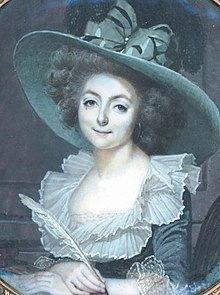Sophie Marie Louise de Grouchy, marquise de Condorcet
Sophie Marie Louise de Grouchy, marquise de Condorcet (born April 8, 1764 in Meulan , † September 8, 1822 in Paris ) was a French salonnière , translator and philosopher . In Paris she ran a philosophical salon.
Life
Marie Louise Sophie de Grouchy was born in 1764 as the eldest child of Francois-Jacques, Marquis de Grouchy, and Marie Gilberte Henriette, née Fréteau de Pény, in the Chateau de Meulan . She had three other siblings. Her sister Charlotte married Pierre-Jean-Georges Cabanis and one of her brothers was Emmanuel de Grouchy , General and Maréchal d'Empire under Napoleon . She was home schooled and educated by her highly cultivated mother and her brothers' teachers. When she was eighteen she attended the Chanoinesse Convent School in Neuville, a school for the wealthy upper class. She learned English and Italian, read the works of Rousseau and Voltaire and became an atheist .
In 1786 she married Marie Jean Antoine Nicolas Caritat, Marquis de Condorcet , a philosopher, mathematician and Enlightenment politician. De Condorcet was an officer of the mint under Turgot and they moved into the building of the mint, the Hôtel des Monnaies , where they founded a philosophical salon, in which members of the international political and literary scene appeared.
Together with her husband and Thomas Paine , Girondin Jacques Pierre Brissot and others, she founded a journal to promote awareness of republican political thought in France. Sophie de Condorcet's texts in the journal were unsigned or were signed “La Vérité”, the truth. She also translated texts by Paine and others and probably wrote her sympathy letters.
This journal, Le Républicain , was discontinued after a few months at Condorcet's request. The reason was the massacre on the Marsfeld , where Sophie de Condorcet and their daughter Eliza were present. In 1793, after the fall of the Girondins, her husband was accused by the now ruling radical Jacobins under Maximilien de Robespierre as "academics, conspirators and enemy of the republic" because he had argued against the new constitution. He had to go into hiding and with the help of his wife Sophie and friends who hid him was able to evade arrest until 1794. During this time Sophie de Condorcet visited him, supported him in his work on his manuscripts for an encyclopedia on the progress of mankind and added passages that were deleted by a later editor. In 1794 Condorcet was arrested and died immediately afterwards. The time of his death is not known, and it is also unclear whether he was poisoned or died of exhaustion and possibly a heart attack.
Since her husband's fortune had been confiscated, Sophie de Condorcet made a living from painting miniature portraits. After the Jacobin reign of terror came to an end, she sent her letters of sympathy to her brother-in-law Cabanis for publication. She also sent her brother-in-law a translation of Adam Smith 's Theory of Ethical Feelings , the quality of which far surpassed the previously published translations. From 1795 until her death in 1822 she devoted herself to editing the works of her deceased husband, she continued to run her philosophical salon and was in lively contact with Cabanis, who dealt with physiology and later with stoicism.
plant
- 1798, Théorie des Sentiments Moraux, suivi d'une Dissertation sur l'Origine des Langues, par Adam Smith, traduit de l'Anglais sur la septième et dernière édition, par S. Grouchy, Ve Condorcet. Elle ya joint huit Lettres sur la Sympathie, Tome II , Paris: Buisson.
Appreciation
American event artist and feminist Judy Chicago immortalized Sophie de Condorcet in the list of 999 women at her dinner party in the 1970s . There her name is written in gold on one of the white, handcrafted, triangular tiles that cover the floor. Her name is assigned to Natalie Barney's symbolic place setting .
literature
- Eduard Maria Oettinger (arr.): Jules Michelet : The women of the French Revolution. Leipzig 1854, pp. 84-102 online
Web links
- Sandrine Berges: Sophie de Grouchy. In: Edward N. Zalta (Ed.): Stanford Encyclopedia of Philosophy .
Individual evidence
- ↑ a b c d e f Sophie de Grouchy by Sandrine Berges, stanford.edu , accessed January 4, 2020
- ↑ a b Why Condorcet? The work of Sophie de Condorcet. In: condorcet.ch. 2019, accessed on January 4, 2020 (German).
- ↑ Brooklyn Museum: Sophie de Condorcet. In: brooklynmuseum.org. Retrieved January 4, 2020 .
| personal data | |
|---|---|
| SURNAME | Condorcet, Sophie Marie Louise de Grouchy, marquise de |
| ALTERNATIVE NAMES | Grouchy, Sophie Marie Louise de (maiden name) |
| BRIEF DESCRIPTION | French salonière, translator and philosopher |
| DATE OF BIRTH | April 8, 1764 |
| PLACE OF BIRTH | Meulan |
| DATE OF DEATH | September 8, 1822 |
| Place of death | Paris |

